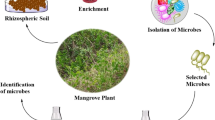Abstract
Decolorization of textile reactive azo dyes by a strain of bacteria (SL186) isolated from a contaminated site was investigated. SL186 was identified as Clostridium bifermentans by phenotypic characterization and 16S rDNA sequence comparison. Under anaerobic conditions, SL186 had decolorized the dyes Reactive Red 3B-A, Reactive Black 5, and Reactive Yellow 3G-P by over 90% after 36 h post-inoculation. The bacterium retained decolorizing activity over a wide range of pH values (6–12), with peak activity at pH 10. Additionally, SL186 decolorized a relatively high concentration of Reactive Red 3B-A dye (1,000 ppm) by over 80% and raw industrial effluent effectively. The addition of glucose increased the decolorization rate a little. Spectrophotometric analyses of the reactive dyes showed no distinct peak indicating aromatic amines. However, a new peak was detected between 300 and 450 nm from the decolorized raw industrial effluent. These results suggest that C. bifermentans SL186 is a suitable bacterium for the biological processing of dye-containing wastewater.



Similar content being viewed by others
References
Aksu Z (2003) Reactive dye bioaccumulation by Saccharomyces cerevisiae. Process Biochem 38:1437–1444
Asad S, Amoozegar MA, Pourbabaee AA, Sarbolouki MN, Dastgheib SMM (2007) Decolorization of textile azo dyes by newly isolated halophilic and halotolerant bacteria. Bioresour Technol 98:2082–2088
Banat IM, Nigam P, Singh D, Marchant R (1996) Microbial decolorization of textile-dye-containing effluents: a review. Bioresour Technol 58:217–227
Chang YC, Okeke BC, Hatsu M, Takamizawa K (2001) In vitro dehalogenation of tetrachloroethylene (PCE) by cell-free extracts of Clostridium bifermentans DPH-1. Bioresour Technol 78:141–147
Chen KC, Wu JY, Liou DJ, Hwang SCJ (2003) Decolorization of the textile azo dyes by newly isolated bacterial strains. J Biotechnol 101:57–68
Delee W, O’Neill FH, Pinhero HM (1998) Anaerobic treatment of textile effluents: a review. J Chem Technol Biotechnol 73:323–335
dos Santos AB, Cervantes FJ, van Lier JB (2007) Review paper on current technologies for decolourisation of textile wastewaters: perspectives for anaerobic biotechnology. Bioresour Technol 98:2369–2385
Fu Y, Viraraghavan T (2001) Fungal decolorization of dye wastewaters: a review. Bioresour Technol 79:251–262
Hammill TB, Crawford RL (1996) Degradation of 2-sec-butyl-4,6-dinitrophenol (Dinoseb) by Clostridium bifermentans KMR-1. Appl Environ Microbiol 62:1842–1846
Knapp JS, Newbym PS (1995) The microbiological decolorization of an industrial effluent containing a diazo-linked chromophore. Water Res 29:1807–1809
Kudlich M, Keck A, Klein J, Stolz A (1997) Localization of the enzyme system involved in the anaerobic reduction of azo dyes by Sphingomonas sp. strain BN6 and effect of artificial redox mediators on the rate of azo dye reduction. Appl Environ Microbiol 63:3691–3694
Kulla HG (1981) Aerobic bacterial degradation of azo dyes. FEMS Microbiol Lett 12:387–399
Lewis TA, Goszczynski S, Crawford RL, Korus RA, Admassu W (1996) Products of anaerobic 2,4,6-trinitrotoluene (TNT) transformation by Clostridium bifermentans. Appl Environ Microbiol 62:4669–4674
McMullan G, Meehan C, Conneely A, Kirby N, Robinson T, Nigam P, Banat IM, Marchant R, Smyth WF (2001) Microbial decolourisation and degradation of textile dyes. Appl Environ Microbiol 56:81–87
Mohanty S, Dafale N, Rao NN (2006) Microbial decolorization of reactive black-5 in a two-stage anaerobic–aerobic reactor using acclimatized activated textile sludge. Biodegradation 17:403–413
Moosvi S, Kehaira H, Madamwar D (2005) Decolorization of textile dye Reactive Violet 5 by a newly isolated bacterial consortium RVM 11.1. World J Microbiol Biotechnol 21:667–672
O’Neill C, Hawkes FR, Lourenco ND, Pinheiro HM, Delee W (1999) Color in textile effluents-source, measurement, discharge contents and simulation: a review. J Chem Technol Biotechnol 74:1009–1018
O’Neill C, Lopez A, Esteves S, Hawkes FR, Hawkes DL, Wilcox S (2000) Azo-dye degradation in an anaerobic-aerobic treatment system operating on simulated textile effluent. Appl Environ Microbiol 53:249–254
Panswad T, Iamsamer K, Anotai J (2001) Decolorization of azo-reactive dye by polyphosphate- and glycogen-accumulating organisms in an anaerobic-aerobic sequencing batch reactor. Bioresour Technol 76:151–159
Paszcezynski A, Pasti-Grigsby M, Goszceynski S, Crawford R, Crawford DL (1992) Mineralization of sulfonated azo dyes and sulfanilic acid by Phanerochaete chrysosporium and Streptomyces chromofuscus. Appl Environ Microbiol 58:3598–3604
Rafii F, Franklin W, Cerniglia CE (1990) Azoreductase activity of anaerobic bacteria isolated from human intestinal microflora. Appl Environ Microbiol 56:2146–2151
Sani R, Banerjee U (1999) Decolourization of triphenylmethane dyes and textile and dye stuff effluent by Kurthia sp. Enzyme Microb Technol 24:433–437
Santhy K, Selvapathy P (2006) Removal of reactive dyes from wastewater by adsorption on coir pith activated carbon. Bioresour Technol 97:1329–1336
Sembries S, Crawford RL (1997) Production of Clostridium bifermentans spores as inoculum for bioremediation of nitroaromatic contaminants. Appl Environ Microbiol 63:2100–2104
Vaidya AA, Datye KV (1982) Environmental pollution during chemical processing of synthetic fibres. Colourage 14:3–10
Weisburger JH (2002) Comments on the history and importance of aromatic and heterocyclic amines in public health. Mutat Res (506–507):9–20
Wesenberg D, Kyriakides I, Agathos SN (2003) White-rot fungi and their enzymes for the treatment of industrial dye effluents. Biotechnol Adv 22:161–187
Young L, Yu J (1997) Ligninase-catalyzed decolorization of synthetic dyes. Water Res 31:1187–1193
Zhao JS, Plaquet L, Halasz A, Manno D, Hawari J (2004) Metabolism of octahydro-1,3,5,7-tetranitro-1,3,5,7-tetrazocine by Clostridium bifermentans strain HAW-1 and several other H2-producing fermentative anaerobic bacteria. FEMS Microbiol Lett 237:65–72
Zollinger H (1991) Colour chemistry: synthesis, properties and applications of organic dyes and pigments. VCH Publishers, Weinheim, Germany
Author information
Authors and Affiliations
Corresponding author
Rights and permissions
About this article
Cite this article
Joe, MH., Lim, SY., Kim, DH. et al. Decolorization of reactive dyes by Clostridium bifermentans SL186 isolated from contaminated soil. World J Microbiol Biotechnol 24, 2221–2226 (2008). https://doi.org/10.1007/s11274-008-9733-3
Received:
Accepted:
Published:
Issue Date:
DOI: https://doi.org/10.1007/s11274-008-9733-3




